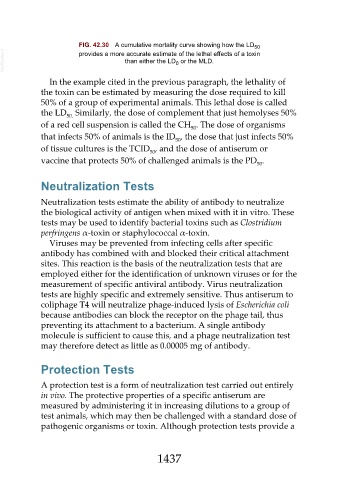Page 1437 - Veterinary Immunology, 10th Edition
P. 1437
FIG. 42.30 A cumulative mortality curve showing how the LD 50
VetBooks.ir provides a more accurate estimate of the lethal effects of a toxin
than either the LD or the MLD.
0
In the example cited in the previous paragraph, the lethality of
the toxin can be estimated by measuring the dose required to kill
50% of a group of experimental animals. This lethal dose is called
the LD Similarly, the dose of complement that just hemolyses 50%
50.
of a red cell suspension is called the CH . The dose of organisms
50
that infects 50% of animals is the ID , the dose that just infects 50%
50
of tissue cultures is the TCID , and the dose of antiserum or
50
vaccine that protects 50% of challenged animals is the PD .
50
Neutralization Tests
Neutralization tests estimate the ability of antibody to neutralize
the biological activity of antigen when mixed with it in vitro. These
tests may be used to identify bacterial toxins such as Clostridium
perfringens α-toxin or staphylococcal α-toxin.
Viruses may be prevented from infecting cells after specific
antibody has combined with and blocked their critical attachment
sites. This reaction is the basis of the neutralization tests that are
employed either for the identification of unknown viruses or for the
measurement of specific antiviral antibody. Virus neutralization
tests are highly specific and extremely sensitive. Thus antiserum to
coliphage T4 will neutralize phage-induced lysis of Escherichia coli
because antibodies can block the receptor on the phage tail, thus
preventing its attachment to a bacterium. A single antibody
molecule is sufficient to cause this, and a phage neutralization test
may therefore detect as little as 0.00005 mg of antibody.
Protection Tests
A protection test is a form of neutralization test carried out entirely
in vivo. The protective properties of a specific antiserum are
measured by administering it in increasing dilutions to a group of
test animals, which may then be challenged with a standard dose of
pathogenic organisms or toxin. Although protection tests provide a
1437

